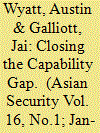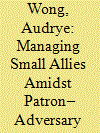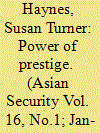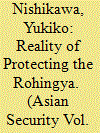|
|
|
Sort Order |
|
|
|
Items / Page
|
|
|
|
|
|
|
| Srl | Item |
| 1 |
ID:
170975


|
|
|
|
|
| Summary/Abstract |
Ostensibly driven by concerns over a military standoff with China similar to Doklam, India increased military deployment at the Myanmar tri-junction. This article assesses the inevitability of systemic factors such as rivalry with China in determining India’s approach on border issues. It asks why India sought formalization of its boundary with Burma in 1967. Given its territorial disputes with China, resolving the Burma boundary should have been high priority. Still, it took India two decades after independence to broach the subject. Based on fresh archival and interview data, this article answers the question by examining the India–Burma Boundary Agreement. A three-party territorial dispute, the making of this agreement witnessed simultaneous interplay between states with visible power differentials, and various stakeholders within India’s polity and bureaucracy. The article argues that even when inter-state competition is apparent, domestic factors may be more important in triggering foreign policy change.
|
|
|
|
|
|
|
|
|
|
|
|
|
|
|
|
| 2 |
ID:
170974


|
|
|
|
|
| Summary/Abstract |
The procurement of autonomous weapon systems is on the rise in Southeast Asia, where, as in other parts of the world, interest in the military applications of unmanned systems is outpacing fractured international regulation efforts. This article analyzes the diffusion of drone technology in Southeast Asia and argues that we are at an inflection point, representing an opportunity for The Association of Southeast Asian Nations (ASEAN) to control the diffusion of unmanned platforms and take a leadership role in developing a regionally appropriate framework for their development. Moreover, it contends that with a regional framework in place to reduce tensions/misadventure, unmanned aerial and maritime vehicles (UAVs & UMVs) could improve ASEAN’s ability to respond to traditional and non-traditional security threats, and thus increase regional security.
|
|
|
|
|
|
|
|
|
|
|
|
|
|
|
|
| 3 |
ID:
170972


|
|
|
|
|
| Summary/Abstract |
The article argues that “first movers” and the bandwagoning effect they trigger can undermine the dynamics that perpetuate civil war and enable a multiparty cease-fire agreement. It looks at the unprecedented “nationwide” cease-fire in Myanmar reached between the government and several ethnic armed organizations in 2015. It shows that democratization and unilateral concessions by the Myanmar government were instrumental in overcoming the commitment problem and provided the necessary incentives for “first movers” to set the stage for a broad cease-fire agreement.
|
|
|
|
|
|
|
|
|
|
|
|
|
|
|
|
| 4 |
ID:
170971


|
|
|
|
|
| Summary/Abstract |
Malaysia has long been hailed as a beacon of moderate Islam. Yet, at present, there is considerable support for ISIS amongst Malaysians, and it represents a unique articulation of contemporary violent Islamist extremism. Malaysians who joined ISIS in Syria and its supporters at home are characterized by a sense of Islamic righteousness. Also, they share distinctive features that differentiate them from the old jihadi generation: a diverse occupational background, the lack of either formal or informal religious training, and the growing nexus of criminality-radicalization. Malaysian support for ISIS can be historically and politically contextualized in relation to the Islamization race between the main political parties, the presence of Salafi-jihadi discourse and ISIS’s discursive construction of authentic Islam.
|
|
|
|
|
|
|
|
|
|
|
|
|
|
|
|
| 5 |
ID:
170977


|
|
|
|
|
| Summary/Abstract |
What explains variation in how a patron manages its existing alliance with a client state when improving relations with an adversary? I theorize that the patron’s alliance management strategy is influenced by the client’s degree of bargaining power over its patron. Bargaining power derives from the availability of an outside option. Using archival and interview evidence, I show variation in alliance bargaining dynamics during US–China rapprochement. While the United States was dismissive toward South Korea, China was highly placating toward North Korea, making concessions and providing compensation. However, China became more dismissive during Sino-South Korean normalization, when North Korea’s bargaining power decreased. The findings have important policy implications for understanding how a patron could simultaneously manage alliance and adversary relationships.
|
|
|
|
|
|
|
|
|
|
|
|
|
|
|
|
| 6 |
ID:
170973


|
|
|
|
|
| Summary/Abstract |
The majority of the nuclear proliferation literature is dedicated to understanding why states acquire nuclear weapons. While this question remains important, it is also advantageous to push beyond this inquiry to ask what motivates a state’s nuclear decisions after acquisition. Recent research indicates that a state’s nuclear force structure is heavily influenced by its threat environment. But what explains decisions relating to specific nuclear weapon systems? If security is a sufficient explanatory variable, then why would a state pursue nuclear weapons with high development and production costs but relatively low security gains? Using China as a case study, this article explores the power of prestige in explaining such decisions.
|
|
|
|
|
|
|
|
|
|
|
|
|
|
|
|
| 7 |
ID:
170976


|
|
|
|
|
| Summary/Abstract |
This article explores the applicability of the notion of the Responsibility to Protect (R2P) in reference to the crisis faced by the Rohingya in Myanmar, and it discusses why the R2P has limited usefulness in certain cases. Since R2P came to be recognized by ASEAN, ongoing community-building activities within the ASEAN led to optimism that member countries would give increased attention to human rights, despite the organization’s historic practice of non-intervention in individual states’ internal affairs. However, the ASEAN’s stance regarding the Rohingya crisis can be described as all talk and no action. While recognizing the value of the R2P in protecting people from mass atrocities in certain contexts, the article points out the critical flaw that R2P rests on a particular discourse of sovereignty. Thus, it argues that the R2P not only has limited usefulness in the case of the Rohingya (whom Myanmar treats as stateless non-citizens) but could even exacerbate the situation.
|
|
|
|
|
|
|
|
|
|
|
|
|
|
|
|
|
|
|
|
|